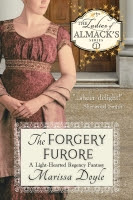Many Regency novels talk about blancmange, either as part of
a dinner or as a comparison to someone’s complexion, character, or personality.
But beloved author Gail Eastwood recently made me realize there are more than
one type of mange. Who knew?
Blancmange is pale and quivering, so you can see why being
compared to it might not be a good thing. It’s a milk-based pudding (in the
sense we use pudding today in America), hence the blanc or white name. It’s
also often flavored with almonds, though the Incomparable Mrs. Beeton, in her Book
of Household Management (1861, after the Regency), recommends arrowroot or
laurel leaves to season it. Think of it as rather bland panna cotta. Regency
folk were quite fond of pouring it into molds and putting it on the table
during the dessert course, though Mrs. Beeton seems to think it could be your
supper. (Dessert for supper—my kind of lady!)
Jaunemange is yellow but almost as quivering. It’s still a
pudding, but the base is egg yolks and it’s flavored with lemon or orange juice,
hence the name jaune or golden, yellow. Another key ingredient was isinglass, a
gelatin-like substance made from the bladders of sturgeon or other fish. It too
was poured into a mold, but it was placed on the table at an earlier course to go
with meats like lamb, veal, or prawns.
So, if you are seeking another dish to consider at your next
feast, Thanksgiving or otherwise, you might consider adding a little mange.
There are a number of contemporary recipes out there like this one and this one.
And speaking of Thanksgiving, Marissa and I will be off
celebrating next week. Come back in December for more tidbits about history and
writing. And presents. ;-)






4 comments:
Fun post, thanks. Happy Thanksgiving!!!
Thanks, Lynn! Happy Thanksgiving to you and yours as well!
There is also blanc mange in my medieval cookbook and I’ve made it. It’s a rice dish with almonds.
Interesting! That sounds better than the recipes I've seen.
Post a Comment